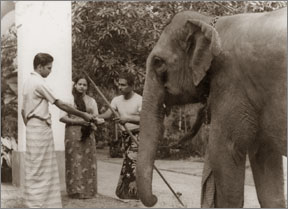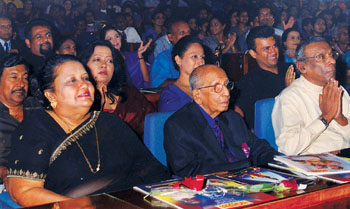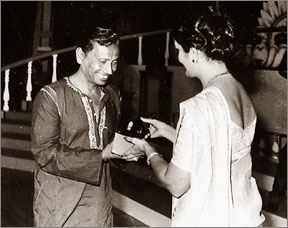Sarasaviya Film Festival and the fortunes of Sinhala cinema
Kalakeerthi Edwin Ariyadasa
|

Kurulubedda
|
Sarasaviya Film Festival, affords a strategic vantage point, to take
a gainful birdâs-eye-view of the sixty-year-old sweep of the history of
Sinhala cinema. In historical hindsight, it can be unambiguously
asserted, that, the tradition of film festivals in Sri Lanka, was
initiated by Sarasaviya - the film journal way back in 1964.
A whole series of film festivals followed in its wake. But with all
that, even today, Sarasaviya Film Festival enjoys the position of the
standard-setter.
The current 31st Sarasaviya Film Festival is, without any doubt, a
far-cry from its early beginnings. In their pioneering days, Sarasaviya
Film Festivals were rather a tame affair.
They held those early festivals, mostly at venues, located away from
the centre of the city, as if thy were afraid to make too much noise.
But, today, in contrast, a Sarasaviya Film Festival is a crucial
cultural event in the country, involving a multitude of cities and
communities.
First Sinhala film
The film community and the public at large, look upon this annual
film festival as a defining event, in the process of the evolution of
cinema culture in Sri Lanka.
As Sarasaviya Film Festival celebrates its 43rd year, Sinhala cinema
itself has travelled some way, beyond its 60th year of existence, since
the first Sinhala film appeared on the 21st of January 1947.
When Sinhala cinema had its birth sixty years ago, the world was
still in the throes of the aftermath of a global war.
|

Sumithra Peries, Lester James Peries and Joe Abeywickrema at a
previous Sarasaviya Award Festival
|
In Sri Lanka, then known as Ceylon, near universal employment and
war-induced inflation ensured a steady flow of cash to most people,
bringing in its slip-stream a euphonic sense of sudden affluence. The
ever-present threat of death and destruction, inevitable in times of
war, though muted to an under-tone, unleashed a keen urge for sensual
pleasures.
The most widespread form of entertainment, available to masses of
that day, was the legitimate theatre. In the new centres of human
settlement, called into existence, through the imperatives of the
war-effort, the travelling theatrical companies, received an adoration,
that verged on the religious.
The Sinhala actors and actresses, who became mass-idols of the day,
could not cope adequately with the ever-burgeoning demand for their
plays. The live presence of a given actor or actress could happen only
at one place at one time.
If the theatre companies were keen to rake in the available Shekels
in a large volume, they had to devise a method of multiplying the
appearance of these actors and actresses, so that they could perform
simultaneously at several centres.
The crucial question was how could this âmiracleâ be achieved?
Cinema, of course, held the key to the solution of this problem. The
proposition was simple: convert the stage play into its âphotographedâ
version-have several copies of it made and you get a simultaneous
island-wide audience for your âplayâ. This exactly ways the thinking,
that resulted in the birth of the first Sinhala film.
Stark economic factor
Thus, we begin to see, that, it was the stark economic factor, rather
than the creative, artistic or the aesthetic, that determined the coming
into being of Sinhala cinema.
|

Cyril Wickramage receiving an award at a previous Sarasaviya Film
festival
|
The historical necessity that compelled the pioneering Sinhala
film-makers to seek South Indian technical facilities and directorial
talent, imparted a marked theatrical bias to the first Sinhala films.
Viewed objectively, we have to accept the fact, that, this was a
historically inevitable development.
However, it was to the credit of the Sinhala film-goer that he grew
tired of this kind of film-fare, within the first decade itself. Unlike
in our neighbouring sub-continent, where mass-taste tends to remain
static for ages in the compact society of Sri Lanka, the nature
attitudes adopted towards other art-forms, inevitably seep into cinema
as well.
In consequence, the generality of film-goers in Sri Lanka discovered
before long, that what was offered to them as Sinhala cinema, was
neither Sinhala nor cinema in the real sense.
Rekhawa
It is in that background, that, Lester James Peries with his
âRekhawaâ (Line of Destiny) of 1956. Shot, almost entirely on location,
when out-door film-making was an unheard-of phenomenon in this region,
âRekhawaâ was a considerable critical success, though a box-office flop
at the time of its initial release.
To my mind, Lester James Periesâ greater achievement is in the field
of film-taste. Undaunted and unfazed by the initial box-office failure
of âRekhawaâ he persisted.
Eventually, the film-goer escaped the hypnotic grasp of the
formula-film and began to acquire a slowly maturing taste for films made
in a truly cinematic idiom. Lester James Peiris is the most notable of
Sinhala film-men, to have evolved entirely within the cinema tradition.
Cinematic talent
The 1960âs stand out as the decade that assembled the most
spectacular array of cinematic talent in the early days of Sri Lanka
cinema.
Lester James Periesâ âGamperaliyaâ, released in the mid-sixties, was
a climactic meeting in the early history of Sinhala cinema, between an
exclusively Sinahala theme and an essentially cinematic interpretation.
In 1965, âGamperaliyaâ won the award for the Best Film in the Third
International Film Festival organized by the Government of India.
Named the âGolden Peacockâ, this Award was an impressive feather in
the cap of Sinhala Cinema. From then on, the film in Sinhala acquired a
prestige it did not possess earlier. People no longer felt that they
should be apologetic about the Sinhala film, like an urban sophisticate
about the coarse ways of his country cousin.
Golden Decade
I deem it proper to characterize the sixties as the Golden Decade of
Sinhala cinema. In the sixties, a feeling for quality started troubling
the conscience of most individuals connected with Sinhala cinema either
as film-makers or film-goers.
A host of talented film-makers, who were essentially men of cinema,
followed Lester James Peries into Sinhala cinema. Some among them, like
Piyasiri Gunaratne, had obtained academic and practical film training
abroad.
From the sixties on, Sinhala cinema began achieving a freshness
through the contribution of such film-men as G. D. L. Perera, Titus
Totawatta, Tissa Liyanasuriya, Siri Gunasinghe, Sugathapala Senerath
Yapa, D. B. Nihalsinghe, Dharmasena Pathiraja, Ranjit Lal, Vijaya
Dharmashri and of course Amaranath Jayatilake.
The momentum of those years, is still being felt in this era of the
21st century.
Of great significance is the evolution of outstanding acting talent.
In their versatility Gamini Fonseka, Joe Abeywickreme and Tony
Ranasinghe proved world-class. Malini Fonseka, Anoja Weerasinghe,
Vasanthi Chaturani earned prestigious recognition, both here and abroad.
What is important to note is that, the transforming presence of these
men and women from the early days of Sinhala cinema, still make waves
down the corridors of time, enriching the cinema memory of our land.
In later years directors of significance, made a determined effort to
venture out of the relative safety of the beaten-track of the formula
and to utilise material which was unquestionably indigenous. An
inevitable outcome of this trend was the search for social issues that
dominated the mind of men and women in Sri Lanka.
Knitting up all these trends and tendencies into a practical resume,
one could unhesitatingly state that the seventies opened with Sinhala
films moving towards the process of evolving into a national cinema.
But, as the seventies progressed Sri Lankan cinema began to fall
victims to unabashed commercialism.
In 1972, the State Film Corporation (now the National Film
Corporation) was established in a State-sponsored bid to counter the
ills that plagued Sri Lankan cinema.
In consequence, a good part of the cinema landscape of the subsequent
years is dominated by the National Film Corporation and its giant
presence.
The best achievement, to my mind, of the 35-year-old National Film
Corporation, is that it has served as a catalyst for change in the field
of Sinhala cinema. The Corporation has brought into being, a diversity
of thinking about Sinhala cinema.
In the early days, the NFC paid considerable attention to the setting
up of a bank of efficiently created screen-plays, the lack of which was
considered the main contributory factor towards the deterioration of the
quality of Sinhala cinema.
In the late seventies the character and the quality of the dialogue
on Sri Lankan cinema, underwent a sudden change and a tone of
unprecedented urgency entered into film-parleys.
Television
The reason for this development was the formal debut of television in
Sri Lanka in 1982. In the affairs of Sinhala cinema in the late
seventies, something like an atmosphere of life and death was in the
air. For the first time since it began, Sinhala cinema was deeply
disturbed, driving those connected with it, to an agonised
soul-searching. The early 1980s were crisis years for Sri Lankan cinema.
In those years, the predominant fact about the status of Sri Lankan
cinema was the rapid dwindling of cinema attendance. With the advent of
TV, each home with television, became an exhibition point for films and
teledramas.
Over and above this, a considerable number of cinema halls fell
victim to terrorist attacks. Adverse impact of TV on cinema, in the
early days of television, is a classical situation in international
media. There were other threats that affected cinema. This was the VHS,
which enabled each home to have its own programme of films. The advanced
DVD, is still very much a bar to cinema attendance.
Those who were associated with film-making migrated to the field of
teledrama. When, incomes dwindled to a trickle some cinemas had to be
closed.
Fortunately for the film industry in Sri Lanka, this gloomy picture
has begun to melt away. New cinema halls, rich with advanced equipment,
have begun to emerge. Generous investment is made available to
film-makers by some outstanding business establishments.
But, with all that, the urgent need is to usher in a new generation
of young persons, adequately trained in film appreciation.
Way back in 1969, when the Junior University system was established,
I was able to introduce the study of cinema at higher education level.
This effort, sadly, is now in abeyance.
Sarasaviya Film Festival, provides a fitting occasion to nurse upon
the fortunes of Sinhala cinema and specifically its present status.
We have award-winning film-makers, whose works receive international
accolade.
But, as we greet yet another Sarasaviya Film Festival, the dominant
figure in the cinema landscape of Sri Lanka - Lester James Peries has
made his farewell film. He is still the establishment to respond to.
It is time we impressed upon those who matter, that an authoritative
discourse on the sixty years of Sinhala cinema, is an urgent cultural
need.
We could make the current Sarasaviya Film festival, the opportunity,
to make a determined commitment to initiate such a responsible and
authoritative discourse.
<<--------------------
BACK to Main Page
|

